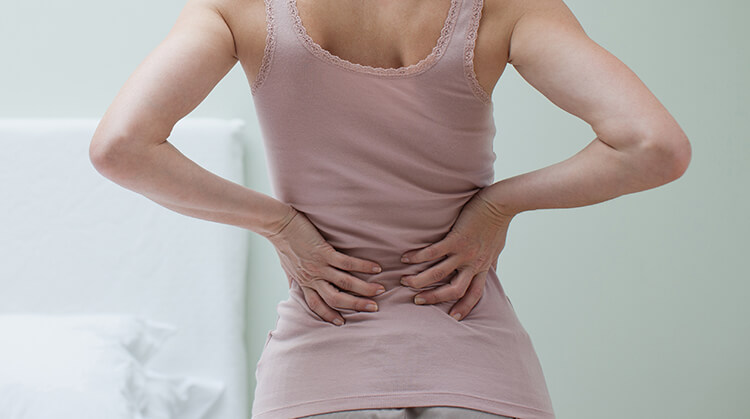Our back pain physiotherapists in London are specialised in back pain treatments and prevention. Find out about the different types of back pain, the common causes and symptoms, and how you can prevent or treat back pain effectively.
What are the common causes of back pain?
Common causes of back pain include pain from the disc, pain from the facet joint (which is the moving part in the back of the spine) and pain from the SSI joint (which is a sacroiliac joint). This can then manifest itself in either a general back pain on itself or back pain and leg pain, which is sciatica. Our physiotherapist will be able to determine the cause of your back pain.
What are the symptoms of back pain?
Common symptoms of back pain include pain in the back as a result of muscular spasm or back pain with pain down the legs, which can cause things like numbness, pins and needles or weakness and is a symptom of sciatica.
What are the causes of back pain due to sciatica?
Sciatica is where the nerves in your spine – which goes down your legs are being pinched. Sciatic nerve compression is normally caused most of the time by a disc prolapse, although sometimes it can be caused by a small piece of bone and disc in combination, causing pressure on the nerve.
What are the causes of back pain due to lumbar spinal stenosis?
Sciatica itself causes numbness, pins and needles and sometimes weakness down the legs. Lumbar spinal stenosis is where the bunch of nerves which run down your legs are pinched, as a result of pressure from the facet, which are overgrowth as well as a disc prolapse. In sciatica, a single nerve is pinched, whereas in lumbar spinal stenosis, most of the nerves are pinched. Therefore, it gives rise to a lot more pain as compared to sciatica.
Arthritis and back pain
Arthritis and back pain can be broken down into two types of arthritis. One is osteoarthritis, which is commonly seen as we get older. This affects the facet joint, as well as the discs. The other type of arthritis is inflammatory arthritis, where there’s a lot of inflammation affecting the discs and the facets. This is commonly associated with conditions such as rheumatoid arthritis, psoriatic arthritis, and other associated sort of diseases.
How does back pain appear? What are the factors that give you back pain?
One of the main reasons for that is because of multiple tears that people get in their discs. We know that all of us get little tears in our discs, which we get with any activity on a day to day living. Sometimes these tears get together and they form a larger disc tear that causes a lot of back spasm. Sometimes, these tears are large enough to cause a disc bulging or disc prolapse, and that’s when you get the leg pain of the sciatica associated with it. Posture itself is very important in ensuring that back pain doesn’t occur for the longer term. For example, sitting on a very deep sofa in a very slouched manner can cause back pain, especially if it’s repeated all the time. Quite similarly, sitting at work in a position where, you’re in a sort of seated position for more than 20 minutes/half an hour is again a cause of back pain. Therefore, these two things need to be looked at with regards to back pain and posture.
How to treat back pain efficiently?
Strengthen your back and abdominal muscles with back exercises
To relieve back pain efficiently, movement is the key. You need to force yourself to exercise regularly, doing the right exercises for your specific back pain. We advise to start with low impact exercises to strengthen your back muscles slowly but efficiently. Once your back muscles start recovering their strength, you can start medium impact exercises and then harder back strengthening exercises.
Back strength is important, but it is more efficient to also strengthen your abdominal muscles as well and tone your core muscles. The combination of these different back exercises will create a natural support belt for your back and relieve you from a lot of back pain.
If you need guidance, our back pain physiotherapist is here to help and give you advices
Stretch your back to make it flexible
While back strength is very important, back flexibility is extremely important too. You should always balance strength and flexibility for a good back health. Your back and mainly lower back support the weight of all your upper body for hours along the day whether you are seated or standing, increasing compression of your spinal discs. Stretching your back regularly will allow to release this pressure and avoid future pain and disc tears.
Physiotherapy and back pain
Back pain physiotherapy assessment
For back pain, we advise to do a back pain assessment with a physiotherapist in order to know exactly:
- Where your back pain comes from?
- Which muscles affect your back pain?
- Which part of the spin need to be worked on?
- Do you need more strengthening that stretching or the opposite?
- What are the most efficient exercises to do to reduce your back pain? (for your specific case)
Back pain physiotherapy treatment
After the assessment, your back pain physiotherapist will use numerous techniques to fasten the release of your back pain. It is usually hands on treatment using manual therapy, manual tensions release, decompression and resistance exercises. He will then provide you with an exercise program to do regularly and tailored to your specific back pain.
If you wish to have more information about our back pain physiotherapist in London and his treatment, you can visit www.excellencephysiotherapy.com
Other articles you might be interested in:


